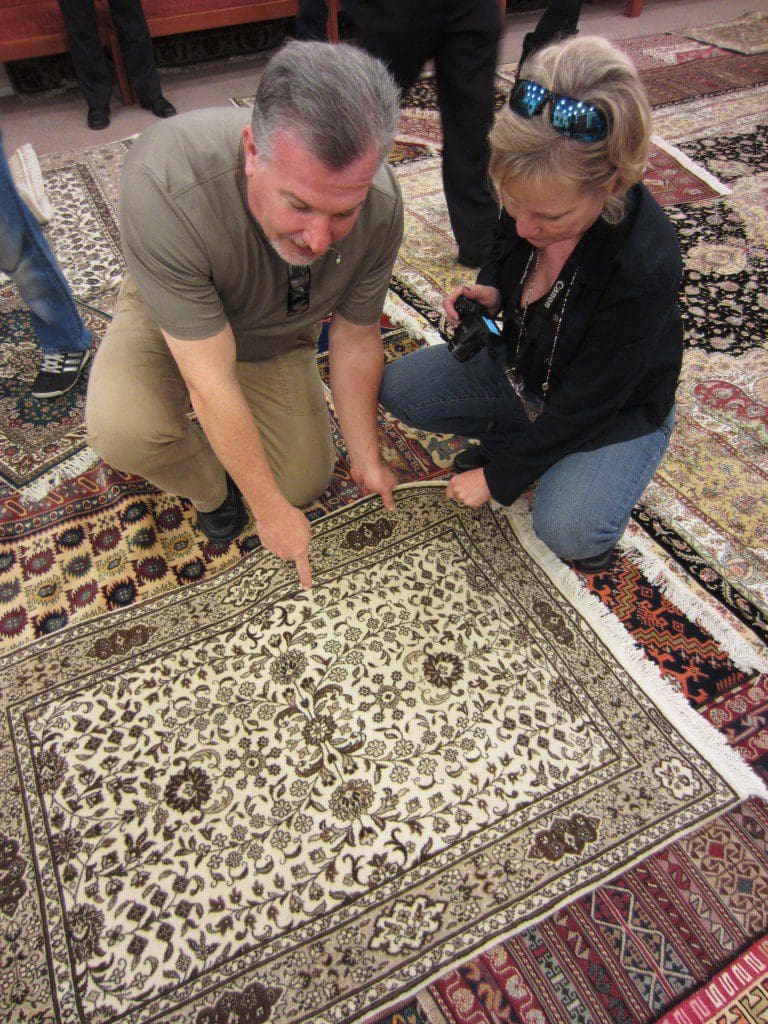 One of the things I did to prepare for my trip to Turkey was to take measurements of rooms in my house where I would like to put a beautiful hand woven Turkish carpet. I wasn’t sure if I could afford such a souvenir but I surely wanted to be prepared if opportunity presented itself.
One of the things I did to prepare for my trip to Turkey was to take measurements of rooms in my house where I would like to put a beautiful hand woven Turkish carpet. I wasn’t sure if I could afford such a souvenir but I surely wanted to be prepared if opportunity presented itself.
As much as I wanted to bring home a Turkish carpet, to be honest, I was a bit intimidated at the thought of the rug buying experience. I’d heard stories of being “trapped” by a beckoning shopkeeper and nearly being drowned in tea after innocently admiring his beautiful wares. I didn’t know the signs of true quality and I was not terribly confident in my negotiating skills. Could I overcome my fears of the quintessential carpet encounter to grace my home with an elegant Turkish carpet? Oh, how I wanted to! A superb Turkish carpet would be an investment that would last a lifetime, even my children’s and grandchildren’s lifetimes. Surely I could do this.
Turkish Carpet Weaving Process
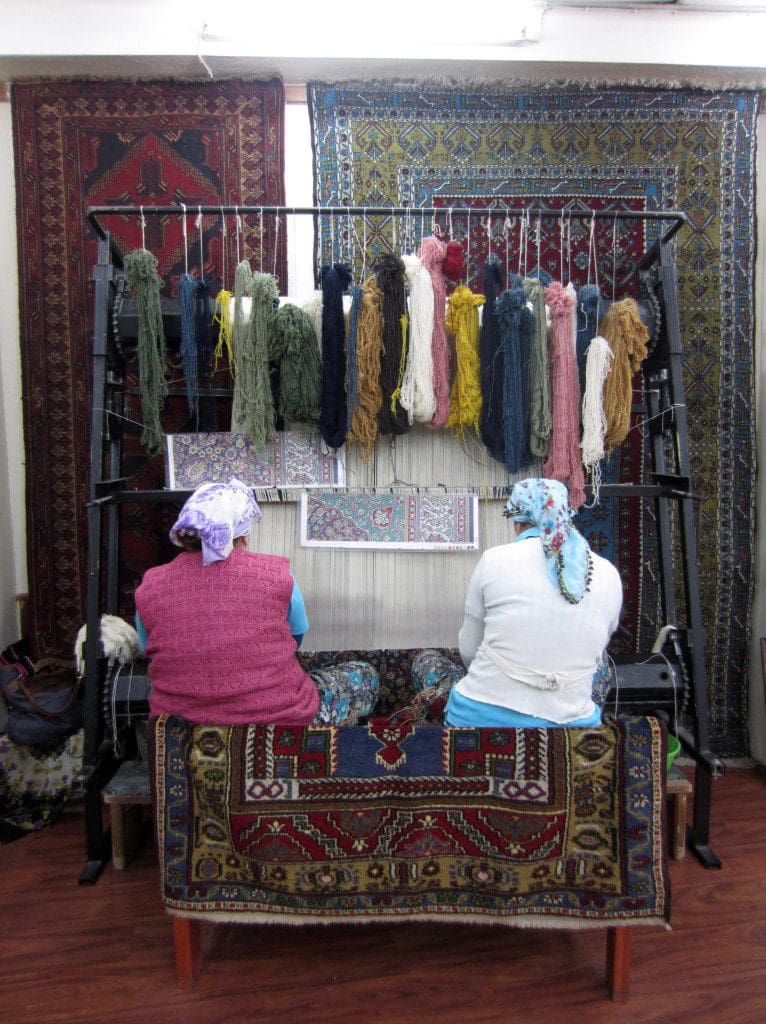 Near Ephesus, we went to Carpetium, a carpet manufacturer’s large showroom and weaving center. First we learned about the weaving process. The special double-knotting technique, unique to Turkish carpet weaving makes the pile incredibly tight and resilient. In this style of weaving, the threads are wrapped twice around the vertical warp and horizontal weft threads, while most other weaving styles only knot the pile threads once on the thread
Near Ephesus, we went to Carpetium, a carpet manufacturer’s large showroom and weaving center. First we learned about the weaving process. The special double-knotting technique, unique to Turkish carpet weaving makes the pile incredibly tight and resilient. In this style of weaving, the threads are wrapped twice around the vertical warp and horizontal weft threads, while most other weaving styles only knot the pile threads once on the thread
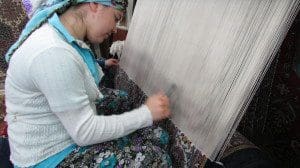
frame. The knots are packed tightly, row after row, making it much less likely to get a “pull” or have threads come loose in the pattern. We watched some women working at huge looms, fingers flying. I even got to try my hand at double knotting and I can attest that it takes a lot of practice and excellent eyesight. The woman whose loom I used probably had to rip out my weaving after I left!
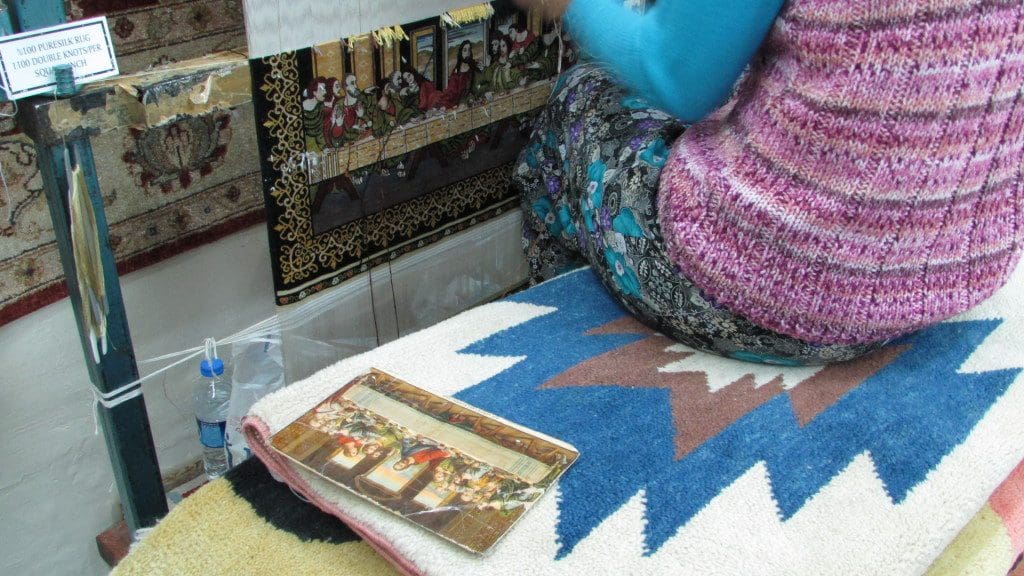
The patterns can be incredibly intricate, depending on the knots per inch. Rugs made with silk, woven on a silk warp and weft (silk-on-silk) can have amazingly high knot density, over 1,000 knots per square inch (KPSI), and thus create extraordinarily detailed patterns. I was in awe of a work in progress that was a reproduction of the Last Supper. Silk-on-silk is the most expensive rug and as such is usually smaller in size and often used as a wall hanging.
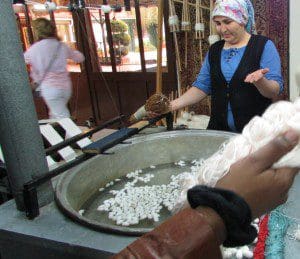 We also saw how the silk is harvested. Silk cocoons floated in a vat of hot water. With a wooden whisk, the lady stirred the pot, capturing thin threads of silk from the cocoons then fed them into a machine that rolled the silk up into skeins. The tiny cocoons bounced and bobbled in the water as they unwound, each one producing up to a mile of very strong silk thread.
We also saw how the silk is harvested. Silk cocoons floated in a vat of hot water. With a wooden whisk, the lady stirred the pot, capturing thin threads of silk from the cocoons then fed them into a machine that rolled the silk up into skeins. The tiny cocoons bounced and bobbled in the water as they unwound, each one producing up to a mile of very strong silk thread.
Wool-on-cotton is more common for larger rugs and those that will be used on the floor. Wool-on-wool is usually used for Kilims, which is a flat weave without knots, similar to an Indian blanket. We learned that natural vegetable dyes are more desirable than artificial ones because the colors don’t fade as much or rub off. We moved through the showroom, marveling at walls covered with dozens of exquisite rugs, to a large room with benches around the edges. There we were offered the ubiquitous tea or Raki (strong anise flavored Turkish alcohol). I went with tea while Todd went for the Raki – I think he was anesthetizing his wallet!
Negotiating for a Turkish Carpet
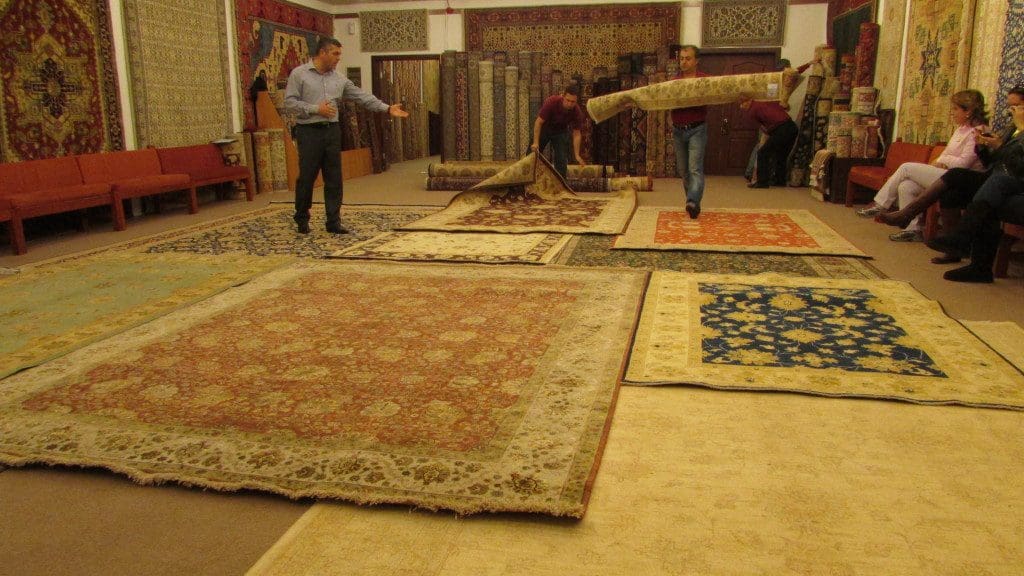 The show began slowly at first; workers rolled out a beautiful rug then another and another, side by side, as the salesman narrated. When the floor was covered, they increased speed and five or six men rolled out rugs with a flourish to a frantic pace. Rug upon rug created an elegant patchwork of sublime color and texture nearly 12-inches deep! It worked, I wanted one. But which one? And no one had mentioned any prices yet. Todd sipped his Raki and I started digging through the rugs.
The show began slowly at first; workers rolled out a beautiful rug then another and another, side by side, as the salesman narrated. When the floor was covered, they increased speed and five or six men rolled out rugs with a flourish to a frantic pace. Rug upon rug created an elegant patchwork of sublime color and texture nearly 12-inches deep! It worked, I wanted one. But which one? And no one had mentioned any prices yet. Todd sipped his Raki and I started digging through the rugs.
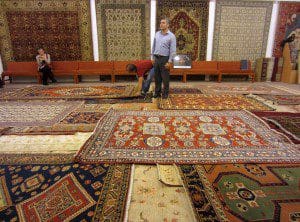 At the first sign of interest, the salesman whisked me into another room and brought in rugs of the colors I desired. It’s OK to ask for prices but the salesman then knows you are interested and the full court press begins. Rule of thumb is to counter offer with about half of the starting price and continue negotiating from there. If you just can’t agree on a price, that’s OK, but it’s considered poor etiquette to settle on a price then walk away.
At the first sign of interest, the salesman whisked me into another room and brought in rugs of the colors I desired. It’s OK to ask for prices but the salesman then knows you are interested and the full court press begins. Rule of thumb is to counter offer with about half of the starting price and continue negotiating from there. If you just can’t agree on a price, that’s OK, but it’s considered poor etiquette to settle on a price then walk away.
The first rug I liked was silk and way out of my budget. The shock on my face when he wrote down the number was probably enough for the salesman to know that he needed to show me a different rug if he was going to make a sale. After much deliberation, I narrowed it down to two wool-on-cotton rugs. When I entered into earnest negotiations, I glanced over at Todd, who now had a larger glass of Raki in hand. This salesman was definitely working with me on softening Todd up! When negotiations seemed to stall, I pulled Todd outside to confer (that means: beg him for approval to spend more than I really intended). Our friends who were waiting outside started snickering – the rug followed us outside! And a bottle of Raki was sitting on the corner!
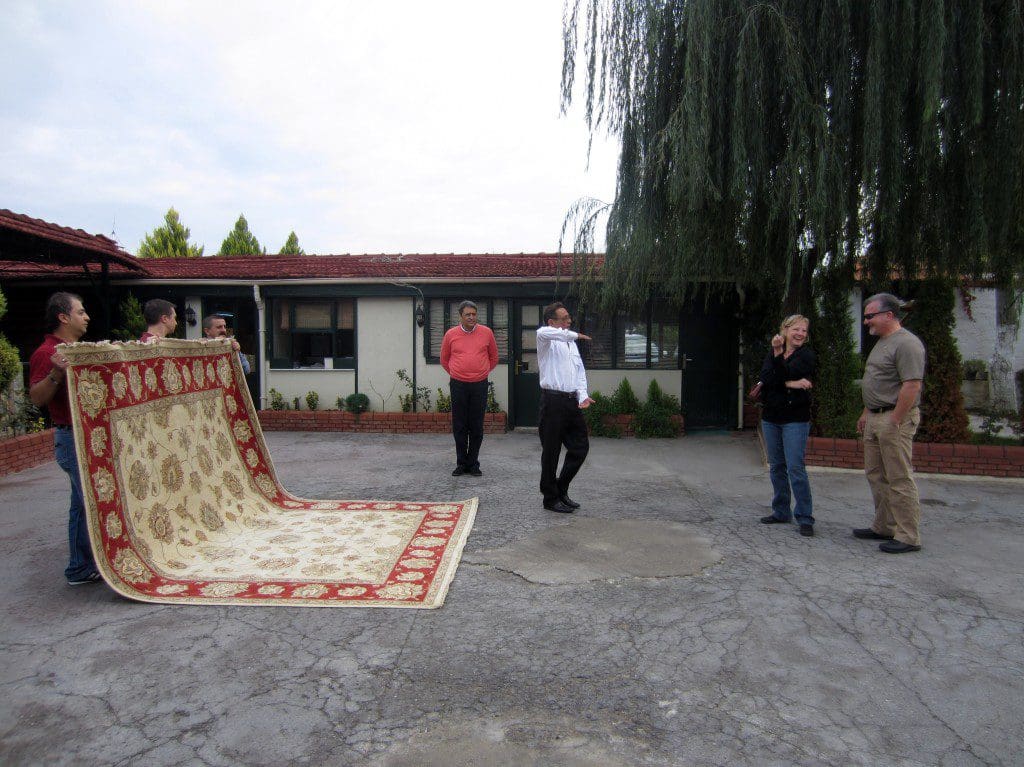 At that point, I think we all knew I was going to buy the rug; we just had to determine who was going to give the last bit in the negotiations. In the end, we shook on a final price (shipping included) and I was the proud new owner of a lovely Turkish carpet! I bargained hard and think I got a good price on an exquisite rug that took a craftswoman in nearby Usak two years to weave. But who knows? Price is so subjective. I do know that had I walked away, that rug would have haunted my dreams, so it was a reasonable price for me.
At that point, I think we all knew I was going to buy the rug; we just had to determine who was going to give the last bit in the negotiations. In the end, we shook on a final price (shipping included) and I was the proud new owner of a lovely Turkish carpet! I bargained hard and think I got a good price on an exquisite rug that took a craftswoman in nearby Usak two years to weave. But who knows? Price is so subjective. I do know that had I walked away, that rug would have haunted my dreams, so it was a reasonable price for me.
How to Not Overpay for a Turkish Carpet:
Here’s my Travel Maestro tip on how to not overpay: Whether the price is a couple hundred or a couple thousand (or even more!), if you can’t live without it and you have negotiated a price you are comfortable paying, make the deal and don’t worry about it. If you are hesitant, even at what you consider a low price, it’s not the rug for you and you’ll be overpaying.
If you’ve also had the fun of a Turkish carpet buying experience, please share a picture on our Facebook page. If you haven’t yet but want to, contact the Covington Vacation Experts to plan your trip.






Really enjoyed your summary. It was just as described. Wish i read it before we went so i would have known where to start negotiations. We really like the carpet and could of negotiated a lower price since did not where to start. It is ok since we have memories of our trip to Turkey!
Thanks for reading, Frank. I think ultimately, as long as you love your Turkish carpet it doesn’t really matter how well you negotiated. I know I think of our wonderful trip to Turkey every time I see my beautiful rug, so that’s “priceless!”
hey, i love your story. i am just disappointed you never mentioned the price you paid 🙁
so how much was it?
Thanks for reading, Mike. See, the thing is, there is no “right price.” The material (wool, silk, etc.), the intricacy of the pattern (time required to weave), the size of the rug, kind of dyes used and the skill of the weaver all factor in. What’s more, your knowledge of all the above and your negotiating skill come into play. Ultimately, the “right price” is the intersection of what you can afford and how much you fall in love with a particular rug. I can tell you that every single time I see my beautiful Turkish carpet, I smile and fondly remember our experience. That means I paid the “right price.” – Beverly
I, too, had the same exact experience. It was overwhelming, exciting, loud (I’ll never forget the banging of the carpets as they hit the floor!), and fun, but I really wish I wd hv read your story first. I didn’t negotiate but the salesman DID find something more in my price range — and now it hangs on my wall bc I’ll be darned if any dirty shoes or stinky feet will touch it 🙂 One tip : Beware, ladies, those Turkish men are handsome, flattering, and smooth talking!
Sherry, you made me laugh! Wasn’t it a fun experience? And one I relive every time I see my beautiful Turkish carpet. If you like your rug hanging, that’s perfect, but folks out there should know that the tight double-knotted hand-woven rugs will stand up to many, many years of foot traffic… stinky feet notwithstanding! Thanks for sharing. 🙂
I have been trying to obtain a tax invoice from the company since July,2016.
An email was received from Can Karaer on 11th August ” apologising for the delay and ‘the documentation you require will be mailed to your address ASAP.”
On 30th August Umit Odabas forwarded an email as a secured / message which could not be opened and I requested the document be re sent as a pdf file or posted to my residential address.
I have since emailed the company on three separate occasions, and no response has been forthcoming.
This would have to be the worst customer service I have ever experienced.
Than goodness I have the rugs in my possession.
John, I’m sorry you experienced this problem. I received my invoice at the time of purchase and a copy with the rug shipment. I can only recommend that you try calling them directly to resolve. Good luck. – Beverly
“Whether the price is a couple hundred or a couple thousand (or even more!), if you can’t live without it and you have negotiated a price you are comfortable paying, make the deal and don’t worry about it.” This sums up perfectly my experience of buying a Turkish carpet. Our cruise ship docked in Kusadasi for the day. After visiting Ephesus, we were taken to a nearby carpet factory/showroom. I had no plans to shop and I was looking at the carpets they were showing to our tour group. And before I realized it, I was ushered to another room and being shown more carpets. It helped that I had a friend with me to confer with. Once I spotted a carpet that hit that spot in my heart, I was a goner. However, I negotiated hard and eventually came to a price that I could afford to pay. FYI, I paid a few thousands for mine. The door to door delivery service was great. A salesman brought it to my house and laid it out where I wanted. I still get routine phone calls from him to check out the carpets he has for sale.
So glad you had a fun experience, Dikash. I wouldn’t trade my Turkish carpet for anything! – Beverly/Travel Maestro
How much roughly USdollar should I pay for 5×7 ft silk on silk medallion rug with 20x 20 knots per inch sq?
Hi Susan, That’s a terrific question, but one I can’t answer. There are so many variables to price, such as the weight/thickness of the material which affects the knots per square inch, the skill level of the weaver and the time required to produce the rug, and most importantly, your negotiating skills! Then there is a question of new rugs versus vintage. A high-quality antique rug can be much more expensive than a brand-new one. I suggest shopping at home before you travel to get a feel for price ranges. Ultimately, if you love your purchase and the price is right for YOU, you made a good deal. Happy shopping! – Beverly, aka Travel Maestro